This is all information that we've recognized proves helpful for our customers to be aware of ahead of time. Taking your time to look over this information could help save you some money and headaches in the future.

Printed Inside Size Tags – When printing care labels inside garments, it's possible for the image to show through to the back of the garment, especially with lighter colored garments. This can be avoided by taking all necessary precautions and using lighter, less detailed artwork on light garments. However, with heavier garments, it may be unavoidable, particularly with dense images that require more ink.
When trying to print a separate image on the outside top center back of a shirt, it's important to keep in mind that this is the same location as the tag print, and conflicts can occur, making it difficult to read both images. Careful placement of artwork can help avoid this issue.
By being mindful of these considerations, you can ensure that your garment printing is of the highest quality and free of unwanted show-through or conflicts between graphics.
Garment De-Tagging – Many blank apparel manufacturers offer tear-away paper tags that allow you to print inside care labels. However, some manufacturers prioritize their own branding by using satin or other woven labels. To take advantage of white labeling services, which allow for custom tags, you may need to meet certain minimums and pay additional fees.

If you are unable to meet the minimum order requirements for white labeling, or if your apparel supplier does not offer this service, there are still other options available. These options can help you ensure that your custom clothing line has professional-looking care labels, even if the manufacturer's branding is prominent.
If you are unable to meet the minimum order requirements for white labeling, or if your apparel supplier does not offer this service, there are still other options available. These options can help you ensure that your custom clothing line has professional-looking care labels, even if the manufacturer's branding is prominent.
While sewing new labels can be effective, it may not be the most professional-looking solution. Consider using a white-labeling service or purchasing apparel that comes with tear-away paper tags or no tags at all to avoid this issue altogether. By taking the time to carefully consider your options, you can ensure that your custom apparel looks polished and professional.
If you prefer not to remove the satin or woven labels from your blank apparel by cutting them out, another option is to take your apparel to a finishing house. They have the necessary equipment to rip the seam of the neck taping, remove the sewn tag, and replace it with your own woven label or care tag.
While this solution may be effective, it can also be costly and time-consuming, as you'll need to transport your apparel to the finishing house and wait for the work to be completed. To avoid this, consider sourcing apparel that comes with tear-away paper tags or no tags at all, or using a white-labeling service to ensure that your custom apparel has professional-looking care labels.
By carefully weighing your options and considering the cost and time involved, you can ensure that your custom apparel has high-quality care labels that meet your needs and budget.

"JUMBO" Screen Prints – A standard size screen can accommodate a graphic up to 15" wide by 17" tall, which is typically large enough to cover the front or back of most standard t-shirt sizes. However, if you need a larger graphic, jumbo sizing options are available, with the largest dimensions typically being 17 inches wide by 21 inches tall. Keep in mind that these prints require larger than normal pallets to load the garment on.
When designing your graphic, keep in mind that the printable area must lay completely flat and should not extend over any seams, hems, pockets, or other design features. Additionally, jumbo prints may not be possible on smaller sizes, as the print area must fit within the dimensions of the smallest garment in your order.
To ensure that your graphic looks its best when worn, consider designing it with the garment's shape and size in mind. This can help you avoid any distortion or loss of detail that may occur when the graphic is stretched or compressed during wear. By carefully considering these factors, you can create a custom t-shirt that looks great and meets your needs.
"All-Over" Printing – For an all-over print, the best method is to print on the fabric panels or rolls before cutting and sewing the garment together. However, this requires specialized machinery that not all print shops have access to. While it is possible to print all-over on a constructed garment like a t-shirt, it can be difficult and inconsistent, especially when printing over seams, pleats, or pockets. Our screen-printing presses can currently print up to 28" wide by 42" long, which may not completely cover your garment end to end. It's best to design with this in mind, creating a graphic with feathered edges. It's also important to understand that printing this way will not allow us to tack the garment in place in order to print multiple colors. Printing larger than the normal printable area of the garment limits the design to a single color. We'll always be upfront about potential inconsistencies in the print due to the nature of screen printing in this manner. Please note that we are not responsible for these inconsistencies.


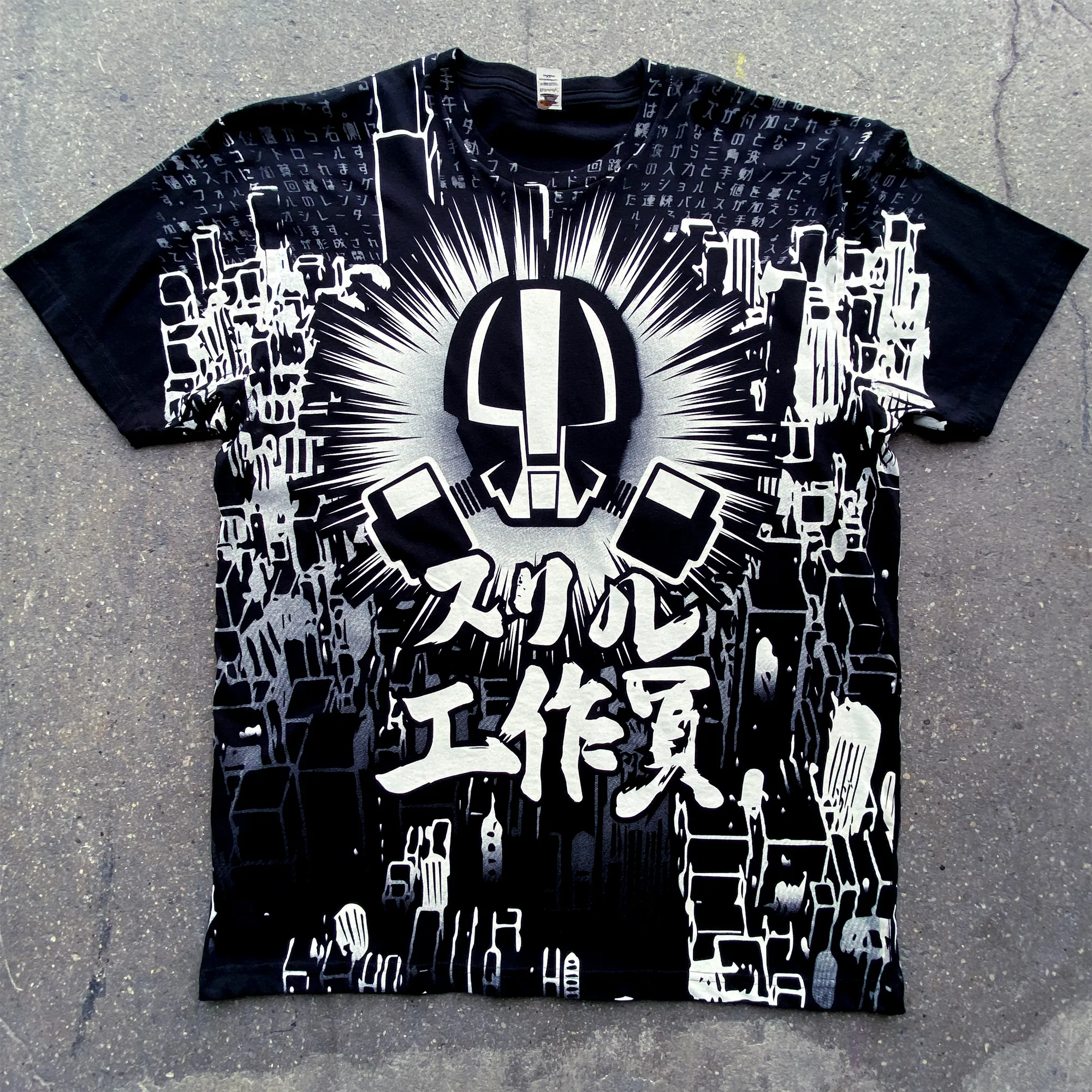

Printing Over Uneven Surfaces – Screen printing requires a smooth and even surface to apply ink evenly. Any disruption in the surface, such as a loose thread, can create imperfections in the print. Therefore, it is strongly recommended not to print over any surfaces that do not lay completely flat. Printing over uneven surfaces can cause the squeegee to skip over parts of the surface, leaving gaps in the print, or allow ink to gather, creating thicker layers of ink and smearing.
Even if we can limit the amount of imperfections shown, inconsistencies in the print are almost guaranteed when printing over seams. Additionally, printing this way takes longer, resulting in higher production costs. We will always be transparent about any potential imperfections before printing, but we cannot be held responsible for these imperfections when printing over uneven areas.
Additionally, we are not able to print over any items that could potentially puncture the mesh screens, such as zippers, rivets, buttons, grommets, etc.
Tiling Prints – Screen printing has come a long way in terms of its processes, but it's still a trade that relies heavily on humans. While it might seem logical to repeatedly print the same graphic on a large fabric panel to create a larger pattern, the human aspect of the process can get in the way of achieving perfection.

Despite the skill of the screen printers, it's difficult to line up prints repeatedly on a flexible fabric, resulting in misaligned prints, as shown in the graphic on the right.
Screen printing a pattern on large areas requires special machinery that can print directly onto a roll of fabric or large panels. Unfortunately, we do not have the equipment necessary to print this way.
Metallic Foil – While screen printing and DTG printing create permanent decorations, foil printing is less permanent and requires proper care and maintenance to preserve its appearance. Although we take all necessary precautions to permanently bind the foil to the garment, it may tarnish or even flake off after a single incorrect wash.
To ensure the longevity of the foil decoration, we strongly recommend washing instructions be included with all foil-decorated garments. It's important to wash these garments inside out with cold water and hang to air dry. It's worth noting that large solid areas of foil may exhibit slight speckling. This is due to lint and other imperfections in the garment. We do our best to minimize the appearance of any such imperfections however, this is sometimes inevitable.
Given this information, foil printing is often best suited for distressed looks, small accents, and designs with primarily negative space. We find that using foil for these types of designs produces the best results.
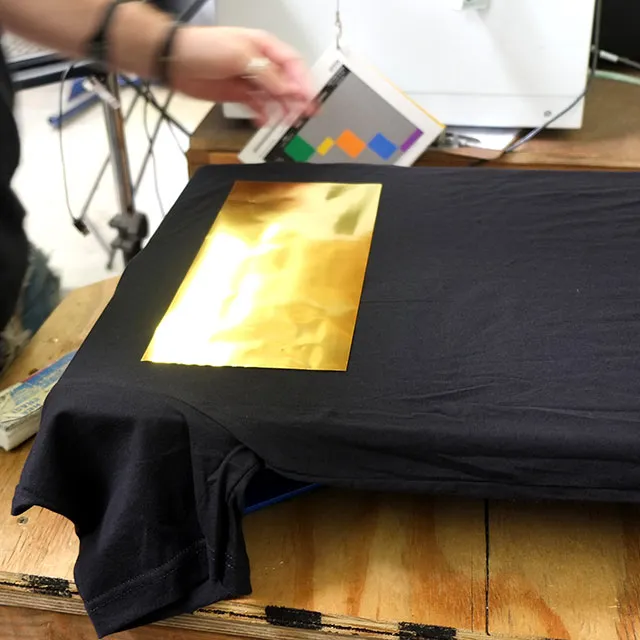
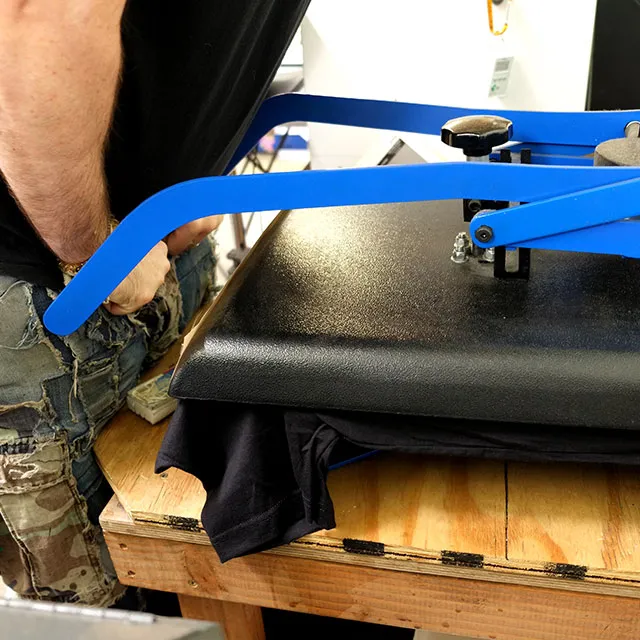
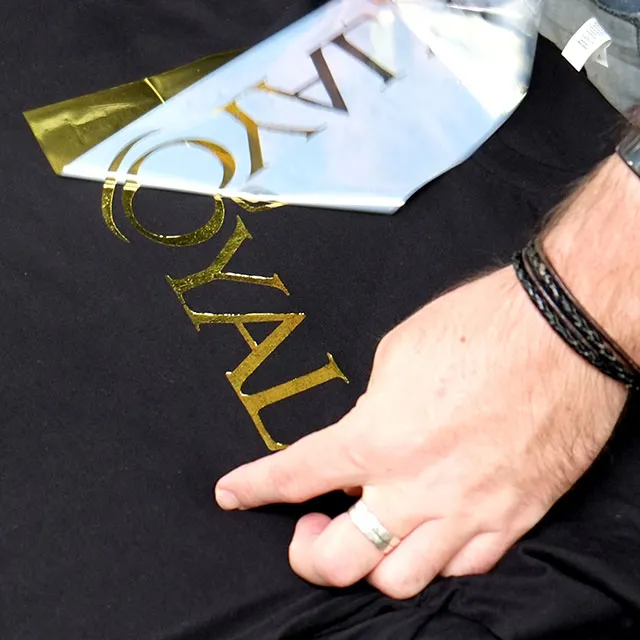
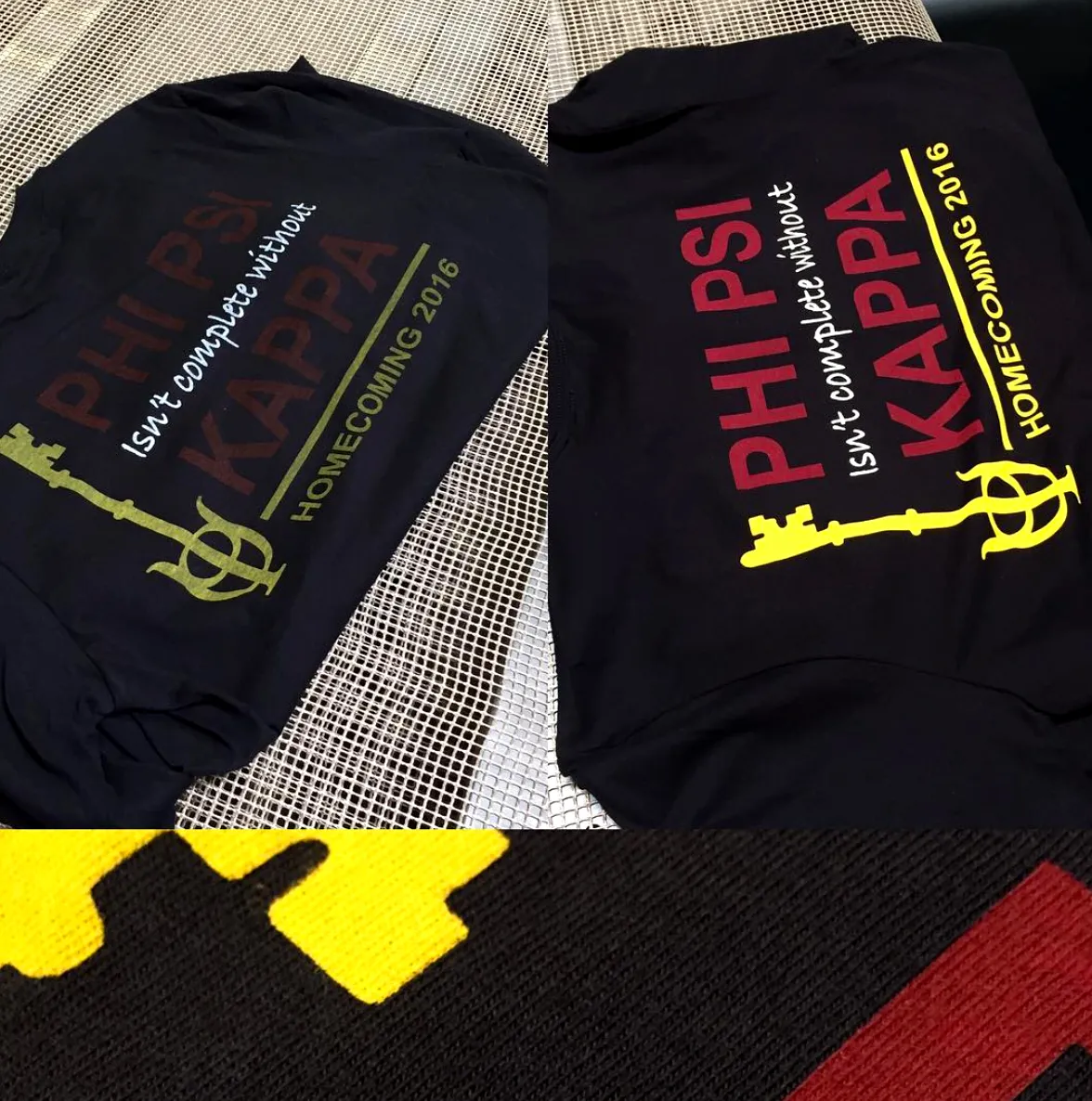
Discharge Ink – Discharge ink is a heat-reactive ink that removes the existing dye on the garment and replaces it with the color dye we've printed as it reaches a high temperature in our dryer. This printing technique has revolutionized the way we print on dark-colored garments while maintaining a soft feel to the fabric.
However, there are some drawbacks to discharge printing. Not all fabrics discharge equally, as the type of dye used varies between fabrics, fabric blends, colors, and manufacturing locations. These variations result in different chemical reactions, making it difficult to guarantee any Pantone color matching.
Certain fabric dyes may not discharge evenly or at all, especially bright greens, reds, and blues. For best results, we recommend using dark-colored cotton garments for discharge printing. Additionally, discharge ink may leave a slight crusty feel on top of the ink after printing due to the heat in the curing process. This feeling will soften significantly after the first wash and continue to soften with subsequent washes, leaving the shirts feeling like the fabric itself. You can see examples of discharge printing here.
Water-based Ink – The common misnomer is that water-based ink is much more environmentally friendly than standard plastisol ink is. With advancements in technology and more stringent environmental regulations, there is very minimal difference in environmental impact between the two. We work primarily with phthalate-free plastisol inks and non-toxic cleaners as a way to remain as "green" as possible. Some might argue that since plastisol ink is far more shelf stable and can be used across more applications, that its environmental impact is far less than the water-based inks that dry quickly in the screens and need to be washed down the drains. The liquid in the ink also makes it much harder to keep stocked for longer as the ink either dries out or begins to spoil and grow mold.
With that being said, water-based ink works best on lighter colored garments to reduce the feel of the ink and preserve the texture of the garment. Light colored garments do not require much of an underbase as the inks are semi-transparent. Darker colored garments may require more passes and thicker layers of ink, negating the use of water-based inks in the first place.
Below you can see examples of light water-based ink on a darker garment and a two-color print with water-based ink on a lighter colored garment. You can see that the light ink on the dark garment is barely visible and the red ink on the yellow garment looks slightly orange due to the transparency causing the colors to mix slightly.
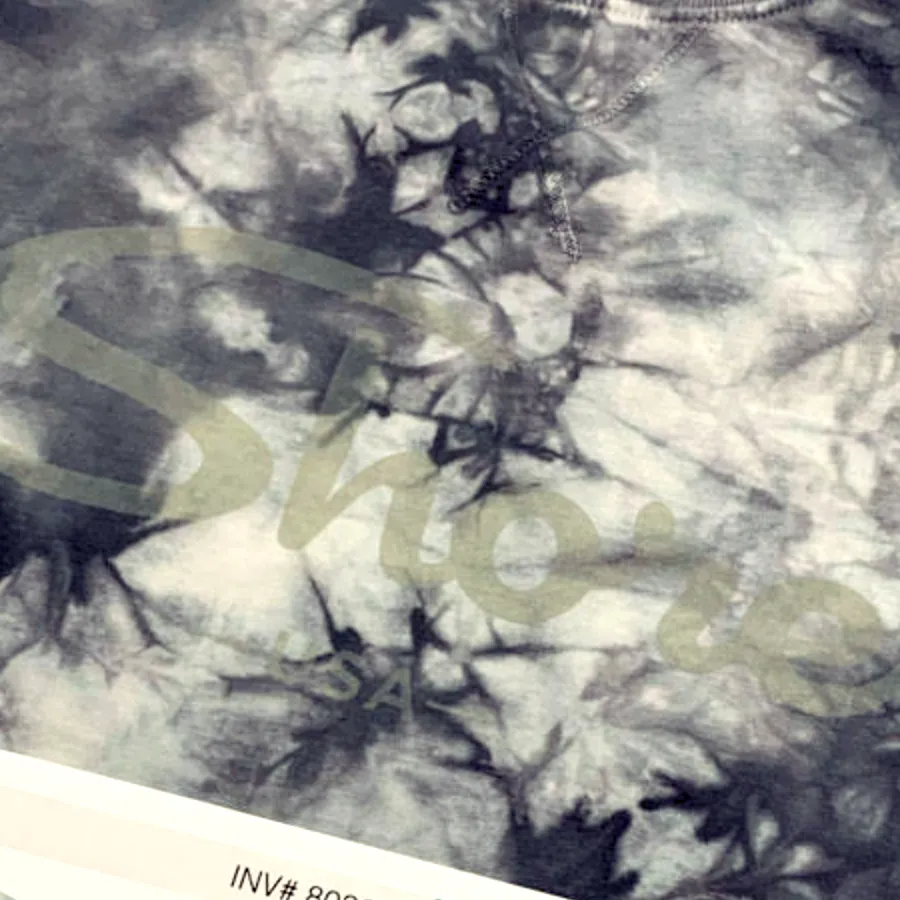

Puff Prints – Puff ink is a type of screen printing ink that has a heat-reactive additive mixed with plastisol ink that causes it to inflate as it cures at high temperatures. Puff ink can be a very interesting way to add depth and texture to a design. However, it is ideal for bold text or outlines but does not work well with large filled-in designs or anything with very fine detail. As the ink inflates, large areas of ink coverage may cure at different rates causing an uneven surface. With fine detail, as the ink inflates, fine lines will thicken up and cause some details like small text to become illegible. The amount the ink will puff also has a lot to do with how flexible the garment is, the softer the garment, the more the ink will be allowed to puff. For more rigid items such as heavy canvas totes, the ink may not puff as much as it would on a soft fleece sweatshirt.
The amount the ink will puff also has a lot to do with how flexible the garment is, the softer the garment, the more the ink will be allowed to puff. For more rigid items such as heavy canvas totes, the ink may not puff as much as it would on a soft fleece sweatshirt. You can see examples below (from left to right) a puff ink print on fuzzy fleece, a puff ink print over an existing plastisol ink print on a cotton t-shirt and puff ink (green) next to regular plastisol (white) on a heavy canvas tote.

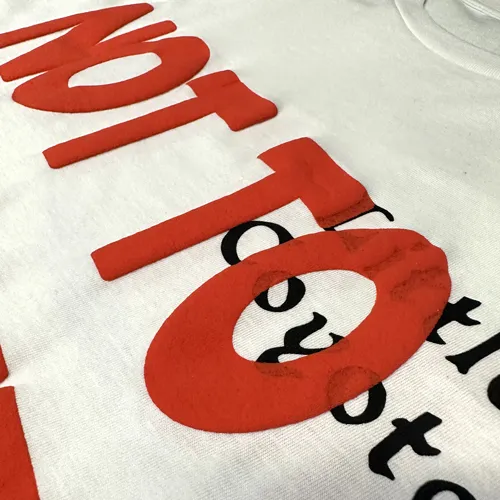
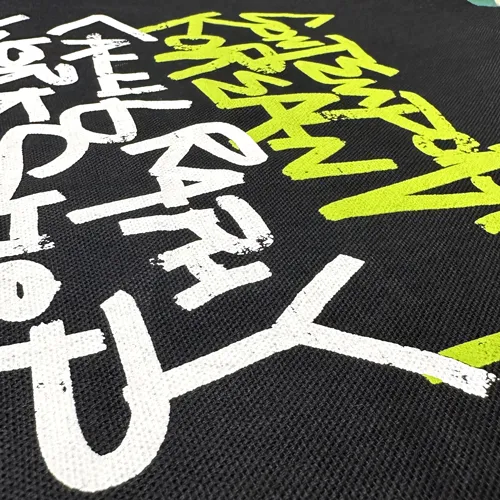
Printing Fine Detail – Screen printing has given us the ability to print very fine detail on a variety of mediums. However, there are certain mediums that prohibit us from being able to replicate this fine detail. These items are usually things that have rough surfaces (canvas tote bags and certain aprons) and any garments made with ribbed, burnout or piqué material. The rougher the material, the more difficult fine detail is to achieve. Also, all metallic inks require lower mesh counts to print the thick metallic pieces through the screen, making it impossible for fine detail to be achieved.
Ribbed Garments – As is the case when printing over seams, hems, or pockets, a ribbed garment does not lay completely flat. The ribs in the fabric will create high and low spots or channels along the print. In some instances, a ribbed garment will look perfectly printed until it is worn and the ribbing is stretched creating a sort of accordion effect on the print itself. Something with more separation between the ribbing like corduroy will allow ink to fill the channels between the ribs leaving a stiff, rubbery print due to the extra ink. Printing on ribbed or overly textured garments like this is not recommended.


Synthetic Fabrics – Blended fabrics that include synthetic materials like rayon, polyester, lycra, etc have become very popular with the rise in popularity of the “athleisure” aesthetic. These synthetic materials are usually inorganic variations of plastic fibers which make them much more sensitive to the high heat required to cure regular screen printing ink.
Due to the heat-sensitive properties of these materials, special considerations need to be taken when printing. Certain additives may need to be mixed into the ink to help it cure at a lower temperature or increase its ability to stretch with the garment. On thinner fabric, we may suggest a lighter print in an attempt to reduce the amount of stiffness a regular plastisol ink print might cause or a more water-based ink option. For this reason, we suggest designing a smaller, less ink-heavy type of graphic or something vintage-inspired for these types of garments. It is best to avoid using regular screen printing ink on blended fabrics that include synthetic materials like rayon, polyester, lycra, etc. Instead, special considerations need to be taken when printing on these materials.
Dye Migration – Synthetic fabric blends contain different types of plastic fibers that can react to the high heat necessary to cure screen printing ink in a way that turns the colorants and dyes used in these fabrics into a gas. That gas can then permeate the ink, tinting it a similar color to the fabric itself. This is most noticeable when printing with bright white ink. For example, when printing white ink on black, if the material gets too hot the print may end up looking gray. To mitigate the risk of this as much as possible, we mix additives into the ink that help reduce the amount of heat necessary to cure or add a base layer that helps block this reaction.
However, there are times where there is a delayed reaction and we may not see the effects of dye migration until days later. In some instances, dyed cotton garments may not be properly set and may contribute to dye migration as well. It is best to avoid printing bright white ink on synthetic fabric blends. Instead, we suggest using a darker ink color or a more water-based ink option.

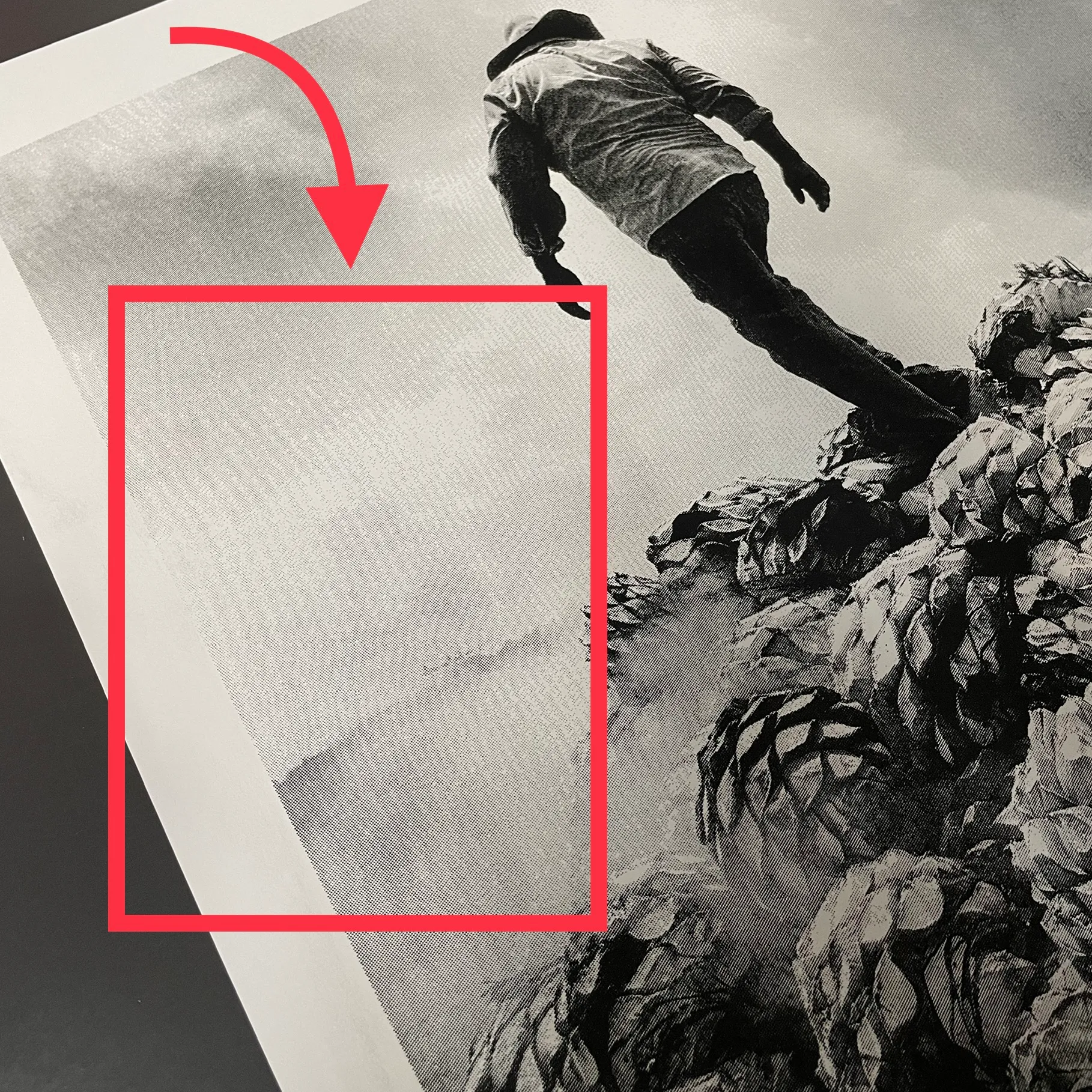
Moiré Patterns – Screen printing cannot recreate blended colors or gradients without converting individual colors into layered halftone dots. Multiple colored dots next to each other will trick your eye into seeing the color you would get if you mixed those colors together. A moiré pattern happens with the angle of those overlaid dots is too similar and creates a sort of patterned distortion. This usually happens when a low resolution graphic already has halftoning and the blurred or pixelated edges are then further halftoned when printing films/burning screens. While we will always do our best to avoid or minimize this effect, we will let you know if there is a risk of this happening prior to moving forward with your project.